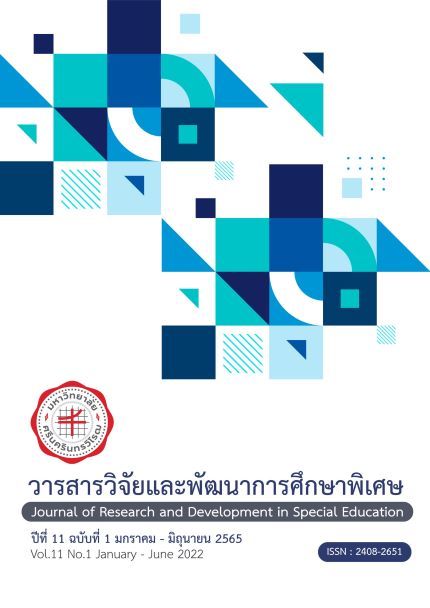ผลการใช้กิจกรรมศิลปะ MATA เพื่อส่งเสริมประสบการณ์สุนทรียะ ในเด็กประถมศึกษาที่บกพร่องทางการเห็น
Abstract
บทคัดย่อ งานวิจัยเชิงทดลองนี้ มีวัตถุประสงค์เพื่อศึกษาผลการใช้กิจกรรมศิลปะ MATA เพื่อส่งเสริมประสบการณ์สุนทรียะในเด็กประถมศึกษาที่บกพร่องทางการเห็น กิจกรรมศิลปะ MATA มีองค์ประกอบสำคัญ คือ 1) พหุประสาทสัมผัส (M: Multiple Sensories) 2) วิธีการสอนเชิงสุนทรียะ (A: Aesthetical Teaching) 3) สื่อ และวัสดุอุปกรณ์ที่มีผิวสัมผัส (Tactile Media) และ 4) การวัด และการประเมินผล (A: Assessment) กลุ่มตัวอย่างที่ใช้ คือ เด็กประถมศึกษาตอนต้นที่มีความบกพร่องทางการเห็นจากโรงเรียนสอนตาบอดกรุงเทพ ที่มีอายุ 6-12 ปีจำนวน 13 คน ใช้วิธีการเลือกตัวอย่างแบบเจาะจง โดยจำแนกเป็น 2 กลุ่ม คือ กลุ่มทดลองใช้กิจกรรมในชั้นเรียนจำนวน 7 คน และกลุ่มทดลองใช้กิจกรรมออนไลน์จำนวน 6 คน เครื่องมือที่ใช้ ได้แก่ 1) กิจกรรมศิลปะ MATA จำนวน 4 กิจกรรม 2) รายการตรวจสอบประสบการณ์เดิมก่อนการทำกิจกรรมศิลปะ 3) แบบสัมภาษณ์เพื่อประเมินประสบการณ์สุนทรียะหลังกิจกรรม ซึ่งอ้างอิงมาจากทฤษฎีสุนทรียภาพของพาร์สัน และ 4) แบบสังเกตพฤติกรรม วิเคราะห์ข้อมูลโดยการวิเคราะห์เนื้อหา ค่าเฉลี่ย และร้อยละ ผลการวิจัยพบว่า กิจกรรมศิลปะ MATA สามารถส่งเสริมประสบการณ์สุนทรียะในเด็กประถมศึกษาที่บกพร่องทางการเห็นได้ เมื่อประเมินจากพัฒนาการทางสุนทรียะ 5 ระดับพบว่าภาพรวมกลุ่มตัวอย่างเกิดประสบการณ์สุนทรียะในระดับที่ 2 ความงามและเหมือนจริง ซึ่งสอดคล้องกับพัฒนาการตามวัยของเด็กที่ทองเห็นปกติ และเกิดประสบการณ์สุนทรียะสูงสุดได้ถึงระดับ 3 การแสดงออก ทั้งนี้ผลการทดลองใช้กิจกรรมในชั้นเรียน และออนไลน์ไม่แตกต่างกัน คำสำคัญ: กิจกรรมศิลปะ, เด็กประถมศึกษาที่บกพร่องทางการเห็น, ประสบการณ์สุนทรียะ ABSTRACT The purpose of this experimental research is to study the effects of MATA art activities on promoting the aesthetic experience of visually impaired primary school students. MATA art activities have four major components: 1) M: multiple sensories, 2) A: aesthetical teaching, 3) T: tactile media, and 4) A: assessment. The sample consisted of 13 students, aged 6 to 12 years old, from The Bangkok School for the Blind. These students were selected by using purposive sampling method. The participants were separated into two groups, the first group of seven participants received on-site activities, whereas the second group of six participants received online activities. The research tools included: 1) four aesthetical MATA art activity plans; 2) a checklist of participants’ past experiences prior to the activities; 3) an after-activity interview for evaluating students’ aesthetic experience, which was developed on the basis of Parsons' aesthetic theory; and 4) students’ behavior observation form. Content analysis, mean, and percentage were used to examine the data. The findings revealed that MATA art activities can promote the aesthetic experience of visually impaired primary school children. The average of participants’ aesthetic experience reached the second level, beauty and realism, which corresponded to the development of children with normal eyesight. The highest level of aesthetic experience was the third level, expressions. Moreover, the results of the on-site and online activities have no difference. Keywords: Art Activities, Visually Impaired Students, Aesthetic ExperienceDownloads
Download data is not yet available.
Downloads
Published
2022-07-04
Issue
Section
Research article




